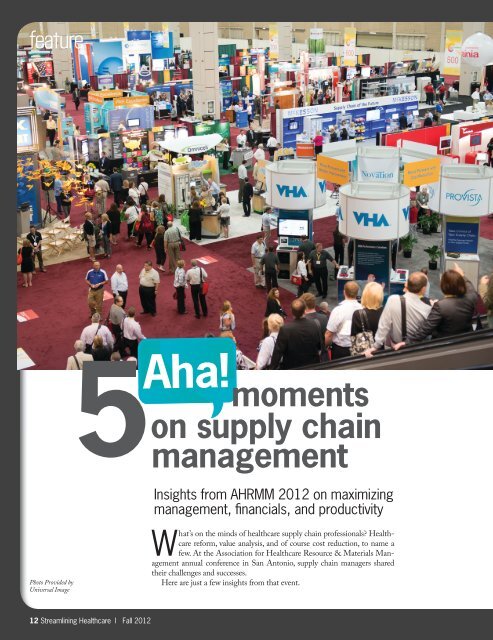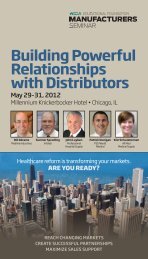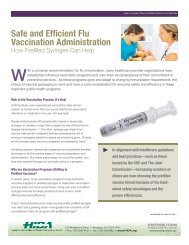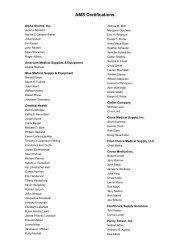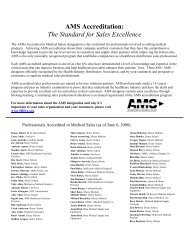5 Aha! Moments on Supply Chain Management (pdf) - Hida
5 Aha! Moments on Supply Chain Management (pdf) - Hida
5 Aha! Moments on Supply Chain Management (pdf) - Hida
You also want an ePaper? Increase the reach of your titles
YUMPU automatically turns print PDFs into web optimized ePapers that Google loves.
feature<br />
5<br />
<str<strong>on</strong>g>Aha</str<strong>on</strong>g>!<br />
moments<br />
<strong>on</strong> supply chain<br />
management<br />
Insights from AHRMM 2012 <strong>on</strong> maximizing<br />
management, fi nancials, and productivity<br />
Photo Provided by<br />
Universal Image<br />
What’s <strong>on</strong> the minds of healthcare supply chain professi<strong>on</strong>als Healthcare<br />
reform, value analysis, and of course cost reducti<strong>on</strong>, to name a<br />
few. At the Associati<strong>on</strong> for Healthcare Resource & Materials <strong>Management</strong><br />
annual c<strong>on</strong>ference in San Ant<strong>on</strong>io, supply chain managers shared<br />
their challenges and successes.<br />
Here are just a few insights from that event.<br />
12 Streamlining Healthcare | Fall 2012
From “Health Care Reform’s Impact <strong>on</strong> <strong>Supply</strong> <strong>Chain</strong> <strong>Management</strong>”<br />
2<br />
1<br />
To have good partnerships,<br />
be a good partner.<br />
“If you really want to get into a<br />
partnership that involves more<br />
than just price, think about how<br />
hard it is to do business with<br />
you. Are we holding an invoice<br />
because it’s off by 12 cents<br />
How much waste is involved in<br />
correcting that”<br />
Mike Rudomin, Principal,<br />
HealthCare Soluti<strong>on</strong>s Bureau<br />
Maximize use of distributors for<br />
regularly purchased supplies.<br />
“About 8 percent of our purchase orders still<br />
have manual data entry. Most of those are<br />
direct-to-manufacturer orders. The manual<br />
processes, the adding of incomplete data, and<br />
the review and sign-off, means that we spend<br />
a disproporti<strong>on</strong>ate amount of time <strong>on</strong> these<br />
orders. In the distributi<strong>on</strong> transacti<strong>on</strong>, many of<br />
those issues are resolved and result in less time<br />
spent <strong>on</strong> a per-line basis. Increased automati<strong>on</strong><br />
also means greater accuracy. We have 0.5<br />
percent price discrepancy with distributi<strong>on</strong><br />
compared to price discrepancy rates of three to<br />
27 percent with direct manufacturers.”<br />
David McCombs, Vice President, <strong>Supply</strong><br />
<strong>Chain</strong>, B<strong>on</strong> Secours Health System<br />
3<br />
Embrace sales reps.<br />
“They are really close to your<br />
doctors and can help you achieve<br />
your goals. Vendors today<br />
understand that they have to sell<br />
to both ec<strong>on</strong>omic and clinical<br />
buyers.”<br />
Eugene Schneller, PhD, Director,<br />
Health Sector <strong>Supply</strong> <strong>Chain</strong><br />
Research C<strong>on</strong>sortium, W.P. Carey<br />
School of Business, Ariz<strong>on</strong>a State<br />
University<br />
From “Ohio State University Medical Center<br />
Productivity Dashboard”<br />
4<br />
From “The Ec<strong>on</strong>omy of Distributors in the <strong>Supply</strong> <strong>Chain</strong>”<br />
5<br />
Set priorities and act accordingly.<br />
“Give up some things that d<strong>on</strong>’t make a big difference. D<strong>on</strong>’t<br />
count 4x4s <strong>on</strong> the floor if doing so means you are not managing<br />
high-dollar items like stents or implants. You may have to give<br />
up something in order to go after the bigger gain.”<br />
Mike Rudomin<br />
Work to reduce<br />
special orders.<br />
“Our percentage of special orders<br />
is 13 percent (down from 20<br />
percent). This is a very important<br />
metric. We want special orders to<br />
be special—the <strong>on</strong>es that really<br />
require human interventi<strong>on</strong>. If<br />
we could eliminate all the ‘special<br />
orders’ that actually could be<br />
automated, we could devote more<br />
purchasing effort to those items<br />
that are truly special.”<br />
Rosalind Parkins<strong>on</strong>, Administrative<br />
Director, The Ohio State University<br />
Medical Center<br />
Fall 2012 | Streamlining Healthcare 13


